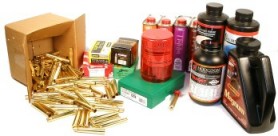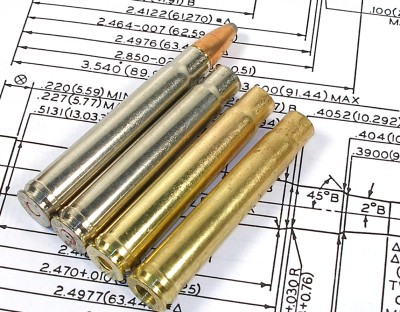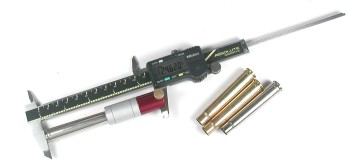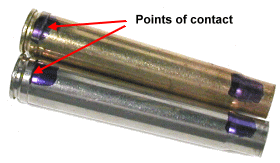
Whenever I begin handloading for an unfamiliar cartridge/firearm combination and I am looking for insight specific to that combination, I think of “The Hitchhiker’s Guide to the Galaxy”. Arthur Dent’s home was on the verge of being demolished by order of the city council. A council employee, Mr. L Prosser, asked Dent if he hadn’t seen the notice. Dent replied, “Yes, yes I did. It was on display in the bottom of a locked filing cabinet, stuck in a disused lavatory with a sign on the door that read Beware of the Leopard“.
General information is readily available. Amongst its sources, some is supportive, some is contrasting, some contradictory. Information can be found on the Internet; some good and some down the block from the new and exciting interpretations of history by liberals, just across the street from great conspiracy theories. Good information can be found in handload manuals, the last place people seem to look, but even these credible sources are devoid if a critical ingredient – unique experience with a specific combination of cartridge and firearm. These days, the test rifle in a universal receiver and not a Winchester Model 70 with a 24″ barrel. So, like Dent, the information isn’t going to be delivered to us, we have to seek it out for ourselves. What COL will a firearm tolerate? How does a cartridge react to light loads? Where is velocity when a bullet is pushed through a 25″ barrel instead of a 22″ barrel? What bullets will group best? That’s where I found myself with the 375 H&H project, and those were some of my questions, so the best place for me to start was of course at the beginning.
Goal Setting
It’s good to have goals. Without them, how would we know when we’ve screwed up ? For that matter, how would we even know when a project is finished. When it comes to handload development for a new cartridge/firearm combination, goals can take into consideration performance within a defined set of circumstance; brown bear at 50 feet, chipmunks at 300 yards. Goals may consider existing inventories of powder and other components and their associated cost. We may need to examine our handloading equipment and check for limitations. Goals may consider accuracy, trajectory or point blank range. At times all of these factors might come into play. So I defined my goals before starting to avoid getting side tracked by shinny objects and other similar distractions and to make sure I cover as many bases as possible.
The table below represents a rough cut at the cost of working up preliminary loads for six bullet types, 600 handloads, for the 375 H&H. It will take twice that amount to optimize a few. This of course does not include my labor, but at 2 cents per hour, there is a lot of it to spend freely.
Item
Quantity Cost
Powder 6.5 lbs $130 Casings 100 ea $40 Bullets 600 ea. $360 Primers 600 ea. $10 Total
$540
This may seem like a lot of bullets. For some narrow applications, this may be true, but the 375 H&H cartridge was selected for its flexibility and the intention was to work up a combination that would be suitable for anything I would ever hunt in North America, beginning with deer and ending with the 13′ brown bear I would surely track down and kill one day. The cartridge needed to have a wide range of bullet weights and jacket yield strengths to be effective. I would utilize full power loads for tough and distant game something significantly less for deer at short ranges. Velocity could be 3,000 fps and it could be 2,000 fps.
Accepting I had little practical experience with this cartridge, I set out to get some first hand experience from the folks who make the bullets as they always have something in mind when they design and produce a bullet. So I called them all and some of them actually talked to me. Based on their input, which ran from verbose to “I don’t know, I just read the spec sheet”, I assembled this lineup for handload development.
| Bullet | Description | Impact Velocity |
Grains | Length |
 |
Hornady InterLock SP FB |
> 1700 |
225 | 1.130″ |
 |
Barnes Triple Shock TSX FB |
> 1600 | 235 | 1.224″ |
 |
Speer Hot-Core SS SP |
> 2000 |
235 | 1.056″ |
 |
Nosler AccuBond Spitzer |
> 1700 | 260 | 1.389″ |
 |
Sierra GameKing Spitzer BT |
> 1900 |
300 | 1.369″ |
 |
Woodleigh PP SS FB |
>1900 | 350 | 1.407″ |
In some cases the bullets were not by design intended for the 375 H&H, however, they would work well as long as they were pushed to the intended velocity and used for the intended purpose. One tidbit I did come away with is the increased strength and broader impact velocity range of some of the newer and lighter bullets. This opened the possibility for a more universal bullet. If a 260 grain Nosler AccuBond will work effectively on moose, mule deer and elk, or even a 235 grain Barnes triple Shock, that would be terrific. Ammunition would be more flexible in application, recoil would be relatively low, cost would be reduced and point blank range would be extended.
A note on recoil. Under any circumstance the 375 H&H, contrary to reputation perpetuated by message board choir boys, does not have severe recoil. I knew a guy, I don’t know him anymore, who use to whine about the 240 Weatherby. Yes, that is a “2” heading up that little string of numbers. My wife shoots a 257 Weatherby and it is her favorite rifle, so I had to stop acknowledging that I knew him. A word of advice to those who continually ask the question, “Does it kick a lot?”, don’t be a big girl about recoil and carrying rifles that weigh more than 6 lbs. It is unbecoming behavior, and such behavior causes me to admit to my wife that most women, these days, are tougher than most men. You can always try fishing of course, although I understand some of those trout can pack quite a wallop. I ad this note for those who wrote to tell me no rifle larger than a 308 can be shot by the average person.
Picking Nits
A critical dimension that is sometimes not defined by published handload data is cartridge overall length, or COL as it is commonly referred….by everyone except the guy who answers the phone at Olympic Arms. This term really means the cartridge’s overall length and not the overall cartridge’s length. To set a correct COL for your gun and handloads you will need an inexpensive COL determining tool like the Stoney Point O.A.L. gauge (don’t ask), a sample of each bullet you will load and a firearm that will generally use the loaded ammo. I am too tired to mill away another barrel and take a bunch of picture so please see the epic story on this site, “Gauging Success – Minimum Headspace and Maximum COL” for excruciating details on all of the gauges and methods I am now going to cover in brief overview.

Because I’m a plodder, when I get a new rifle I clean it up, pick up some common ammo types, take both to the range and do some baseline shooting. Then I haul everything back to the shop and start poking around in the “evidence” to find some insight that would help with handloads. Left to right: Federal 300 grain round, an empty case from the same, new Remington brass for comparison, a Stoney Point COL gauge case insert, and a SAAMI specification page for the same cartridge to act as a nifty background for the picture for those who think I make this stuff up.
 Belted magnums are a little tricky because the headspace contact surface is technically the forward edge of the belt. However, when fired, the case will expand to fill the gun’s chamber and may move the shoulder forward. Neck or minimal full length resizing is typically adjusted to the gun’s chamber, which may cause the shoulder contact to become the headspace control surface and not the belt. The case insert used as a part of the Stoney Point gauge is made from an unfired cartridge. For it to be useful in determining critical measurements for handloads, the position of its shoulder would need to be close to that of a live cartridge fired in the gun’s chamber. I measured headspace length on factory ammo, new brass, fired brass and the Stoney Point gauge.
Belted magnums are a little tricky because the headspace contact surface is technically the forward edge of the belt. However, when fired, the case will expand to fill the gun’s chamber and may move the shoulder forward. Neck or minimal full length resizing is typically adjusted to the gun’s chamber, which may cause the shoulder contact to become the headspace control surface and not the belt. The case insert used as a part of the Stoney Point gauge is made from an unfired cartridge. For it to be useful in determining critical measurements for handloads, the position of its shoulder would need to be close to that of a live cartridge fired in the gun’s chamber. I measured headspace length on factory ammo, new brass, fired brass and the Stoney Point gauge.  The resulting measurements were: 2.461″, 2.460″, 2.467″ and 2.461″ respectively. The tolerance allowed by the case drawing at those reference points is 2.464″ / – 007″, so there was no reason the Stoney Point cartridge gauge would not be valid in determination of cartridge overall length. As a further check I put some layout blue on the case gauge and a couple of fired cases, chambered them and checked point of first contact. Both contacted at the belt and not on the shoulder, making the belt a stable reference point.
The resulting measurements were: 2.461″, 2.460″, 2.467″ and 2.461″ respectively. The tolerance allowed by the case drawing at those reference points is 2.464″ / – 007″, so there was no reason the Stoney Point cartridge gauge would not be valid in determination of cartridge overall length. As a further check I put some layout blue on the case gauge and a couple of fired cases, chambered them and checked point of first contact. Both contacted at the belt and not on the shoulder, making the belt a stable reference point.
Powder Selection
I have more canisters of little used powder types than I deserve. I begin on solid footing, selecting from listings in manuals, then discover the “best” choice often produced the lowest velocity and the poorest level of accuracy. When this happens with moderate speed powders I don’t mind so much because the powder can then be used elsewhere pretty easily. When it happens with the extreme of fast or slow powder, I tend to get a little grumpy and begin to understand why some people spend a lot of time at guns shows dumping handloading material. I have lots of powder in the event I begin to handload for the 20mm canon round, and I am pretty much all set for a run on the .14 Pee Wee. Fortunately, the 375 H&H with it’s relationship of a relatively large bore for its case capacity, and it’s out of shape drooping shoulders, only requires mainstream powder of moderate speed. I had a ready supply to draw from. I think the table below illustrates the overlap.
| Cartridge | Capacity:Bore Ratio |
Popular Bullet Weight Range |
Popular Powder Selections |
| 222 Remington | 117:1 | 50-55 | AA2520,H335, IMR4198,IMR4895,Win748 |
| 308 Winchester | 184:1 | 165-180 | AA2520,H4895,RE15,Varget,Win748,Win760 |
| 220 Swift | 217:1 | 50-55 | AA4350, IMR4350, H414, RE15,RE19 |
| 243 Winchester | 221:1 | 85-100 | H4350,H4895,IMR4831,RE19,RE22,Varget,Win760 |
| 30-06 Springfield | 225:1 | 165-180 | H4350,H4831,IMR4064,IMR4350,RE15,RE19,Win760 |
| 375 H&H | 246:1 | 270-300 | H4895,H4064,IMR4350,RE15,Varget,Win760 |
| 280 Remington | 250:1 | 145-160 | IMR4350,IMR4831,IMR7828,RE19,RE22 |
| 7mm Remington Magnum | 284:1 | 145-175 | AAMagproH760,H1000,RE19,RE22,RE25,WIN WMR |
| 270 WSM | 290:1 | 130-150 | AA3100,IMR4350,IMR7828RE19,RE22,RE25,WIN WMR |
| 257 Weatherby | 305:1 | 100-120 | IMR4350,IMR4831,IMR7828,H760,RE25 |
| 30-378 Weatherby | 398:1 | 165-220 | AA8700,H50BMG,H870,H1000,IMR7828,RE22,RE25 |

I elected to go with the powder selection picture left. You can probably tell from the color scheme of some of the containers that they date to just after WWI when I was still a young man wearing one of those pretty groovy doughboy helmets. I like Varget. I’ve had excellent results where I’ve work up handloads based on this powder and I am a big Alliant fan, even if they can’t spell Reloader and leave people outside of our spot with the impression handloaders can’t spell gooder. IMR is of course always good product and, now that they are a part of Hodgdon, they may have the resources to become even better. Time will tell. I hope they don’t get absorbed and we lose a selection of powder in yet another consolidation of companies.
Next up..
The last installment will provide tested handload data as well as anything I might stumble across while involve in the process. I also had some time to make some aesthetic changes to the CZ you may, or may not, like. I’ll be back in a couple of weeks and then the site will be taking on a quite different direction.
Get The Big Gun…and call me Bwana Part I
Get The Big Gun…and call me Bwana Part II
Get The Big Gun…and call me Bwana Part III
Thanks
Joe

Email Notification